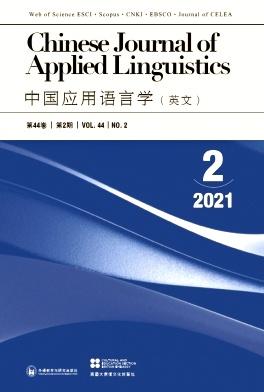On the Novel Chinese Modifier-Head Construction Shejian Shang de X : An Analysis of Meaning Construction
IF 1.1
4区 教育学
Q3 EDUCATION & EDUCATIONAL RESEARCH
引用次数: 0
Abstract
Abstract Since the documentary A Bite of China (i. e. Shejian shang de Zhongguo ( 《舌尖上的中国》), where shejian shang literally means “on the tip of the tongue”), was broadcast in May 2012, a great number of expressions like shejian shang de Russia/world/Olympics/safety have begun to gradually converge into a novel modifier-head construction Shejian Shang de X , illustrating a typical evolution of modern Chinese.This study aims to analyze the construction’s meaning from the perspective of cognitive linguistics. Our investigation and analysis indicate that (1) Shejian Shang de X differs from the classic Chinese construction PP de X in both semantics and syntax; (2) as a modifier-head construction, Shejian Shang de X shows its variations in the head X’s multiple category options (noun, verb and adjective), therefore extending the scope of nominalization in Chinese and simultaneously triggering the construction’s diversified meanings; (3) the construction’s non-compositionality results mainly from its modifier components shejian and shang and is in general construed metonymically and metaphorically; (4) as a whole, the construction is a double-scope network consisting of two different organizing frames: the frame of shejian (“tip of the tongue”), a body part term and the frame of X, a dynamically changing entity (physical or abstract). The surface semantic incompatibility between the modifier and the head can be solved only by virtue of conceptual blending, producing the novel meaning [X relevant to the function of the tip of the tongue] of the whole construction.论汉语新修饰语头结构社间尚德X:意义结构分析
自2012年5月纪录片《舌尖上》(“舌尖上”的字面意思是“舌尖上”)播出以来,诸如“舌尖上”、“俄罗斯”、“世界”、“奥林匹克”、“安全”等大量表达开始逐渐汇聚成一个新颖的修辞格——“舌尖上”X,体现了现代汉语的典型演变。本研究旨在从认知语言学的角度分析该结构的意义。我们的调查和分析表明:(1)社建上德X在语义和句法上与汉语经典构式PP德X不同;(2)作为修饰语-头部结构,“社间尚德X”在“X”的多范畴选项(名词、动词和形容词)中表现出变化,从而扩大了汉语名物化的范围,同时引发了该结构意义的多样化;(3)构式的非组合性主要是由于其修饰语“社”和“还”造成的,一般是通过转喻和隐喻来解释的;(4)整体而言,建构是由两种不同的组织框架组成的双范围网络:身体部分术语“舌尖”框架和动态变化实体(物理或抽象)“X”框架。修饰语与词头之间的表面语义不相容只能通过概念的融合来解决,从而产生整个结构的新意义[与舌尖功能相关的X]。
本文章由计算机程序翻译,如有差异,请以英文原文为准。
求助全文
约1分钟内获得全文
求助全文
来源期刊

Chinese Journal of Applied Linguistics
EDUCATION & EDUCATIONAL RESEARCH-
CiteScore
1.50
自引率
0.00%
发文量
377
期刊介绍:
The Chinese Journal of Applied Linguistics (CJAL) (formerly known as Teaching English in China – CELEA Journal) was created in 1978 as a newsletter by the British Council, Beijing. It is the affiliated journal of the China English Language Education Association (founded in 1981 and now the Chinese affiliate of AILA [International Association of Applied Linguistics]). The Chinese Journal of Applied Linguistics is the only English language teaching (ELT) journal in China that is published in English, serving as a window to Chinese reform on ELT for professionals in China and around the world. The journal is internationally focused, fully refereed, and its articles address a wide variety of topics in Chinese applied linguistics which include – but also reach beyond – the topics of language education and second language acquisition.
 求助内容:
求助内容: 应助结果提醒方式:
应助结果提醒方式:


